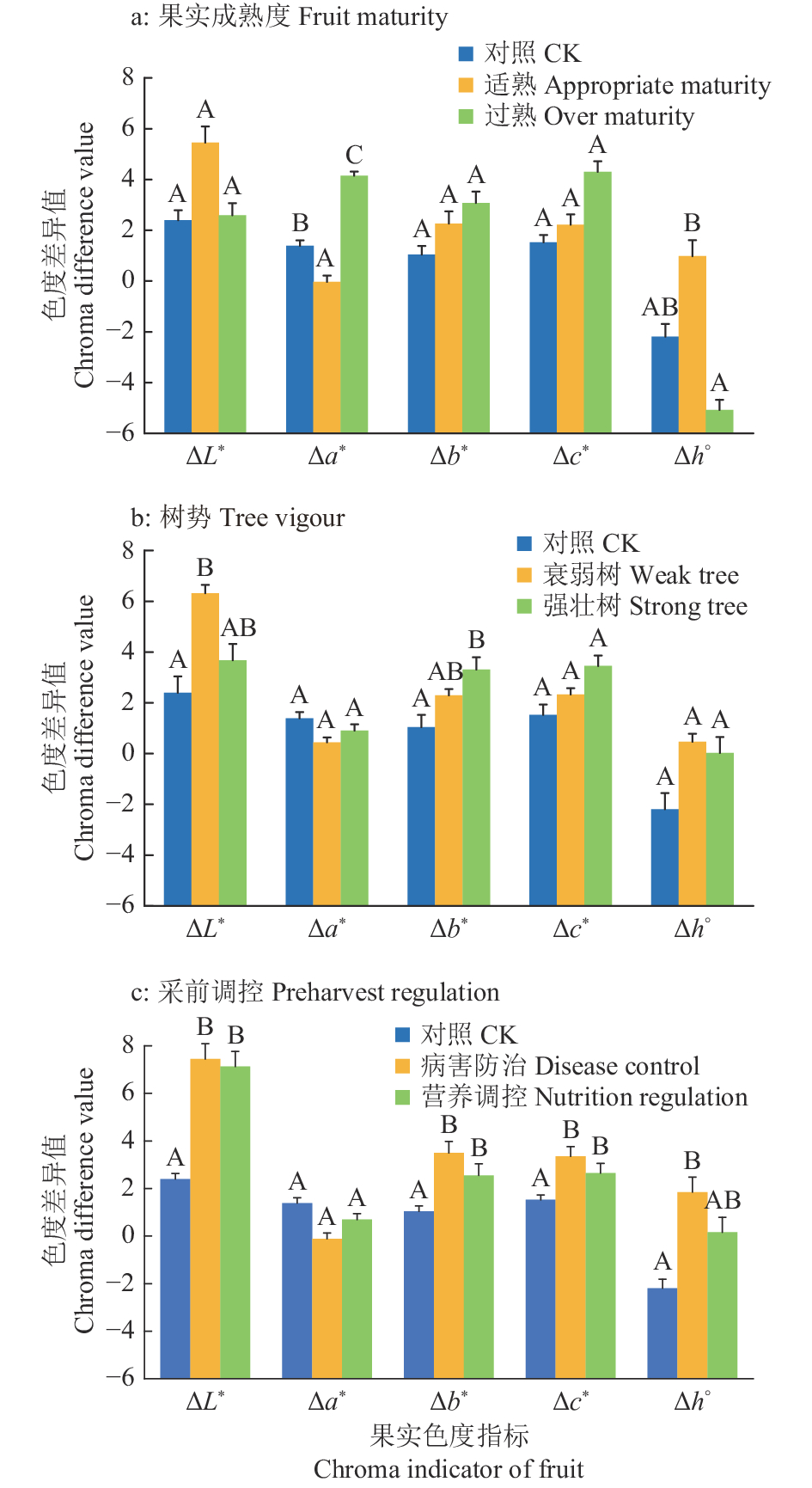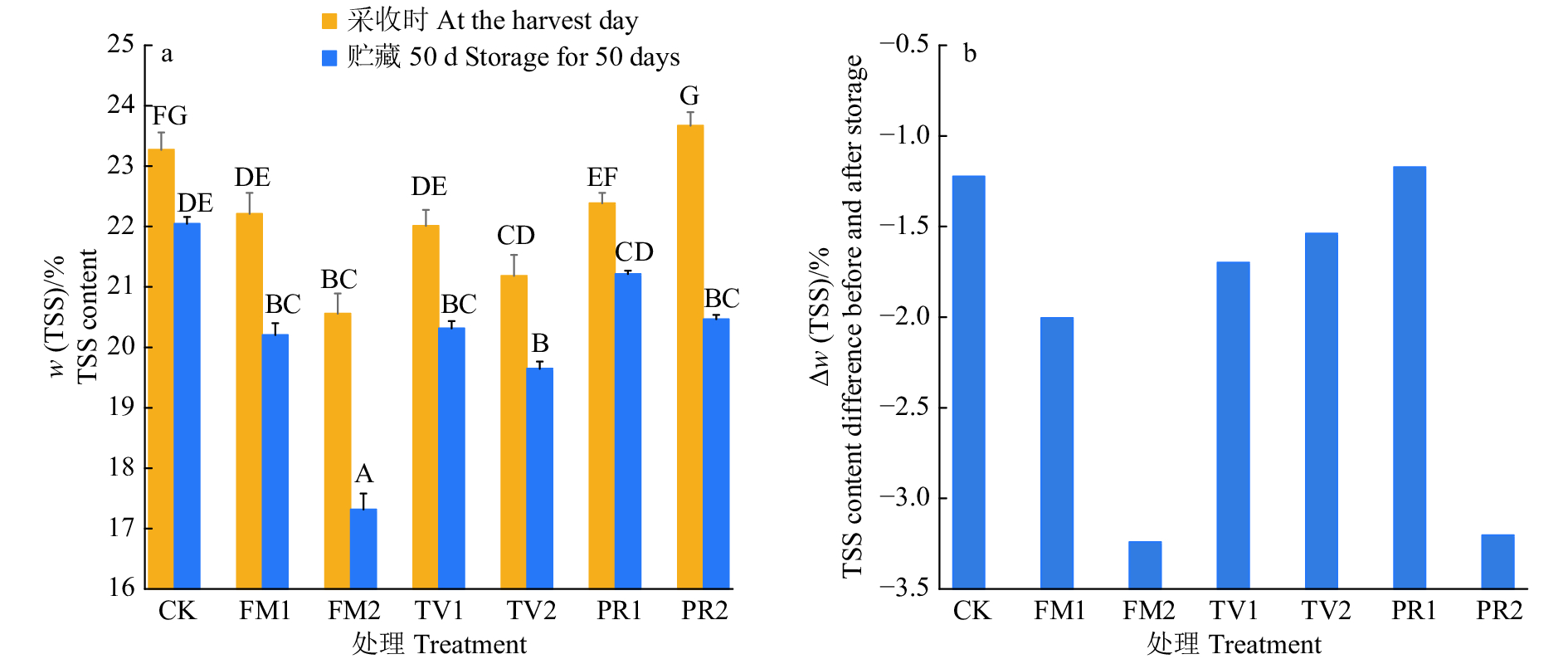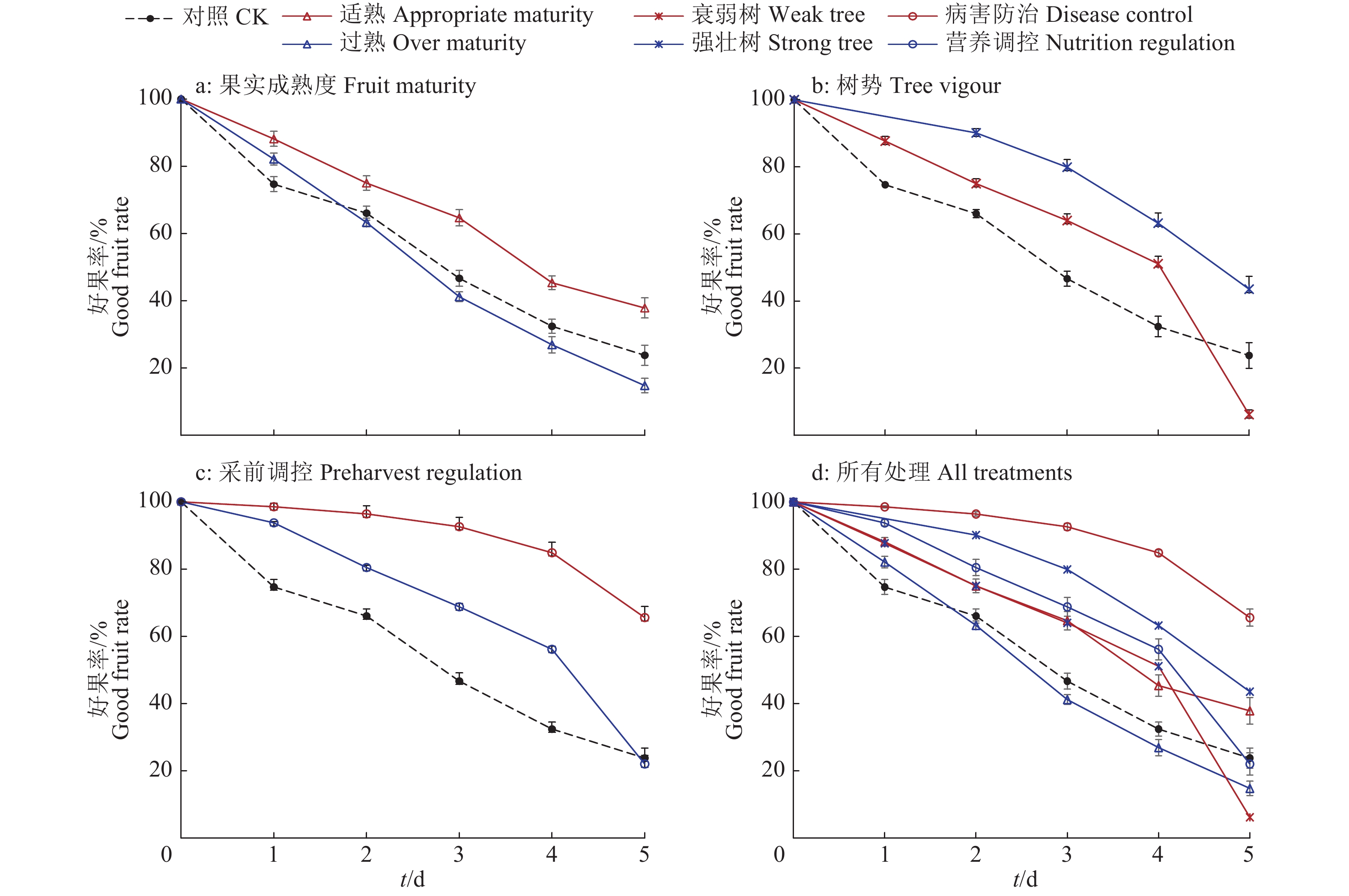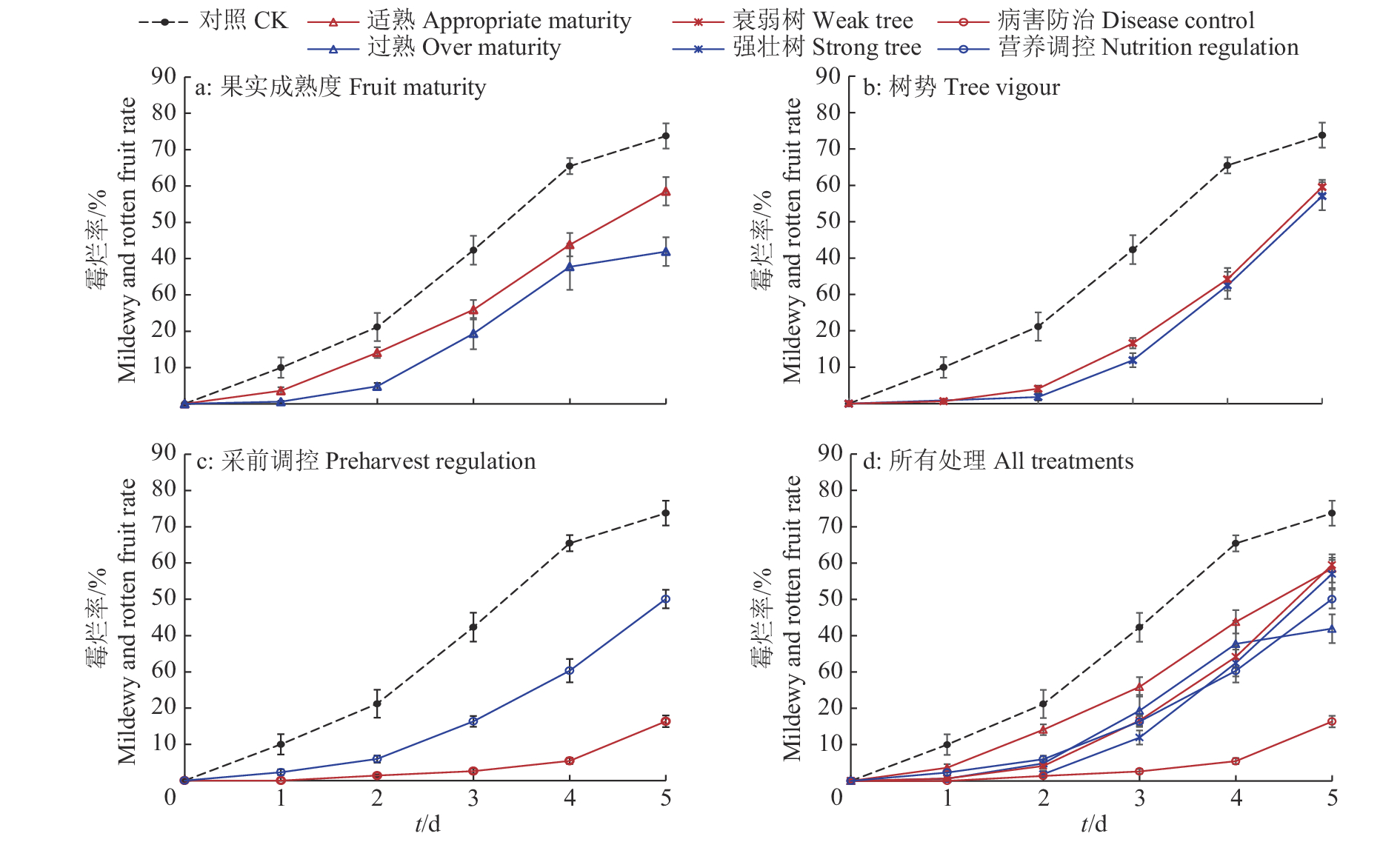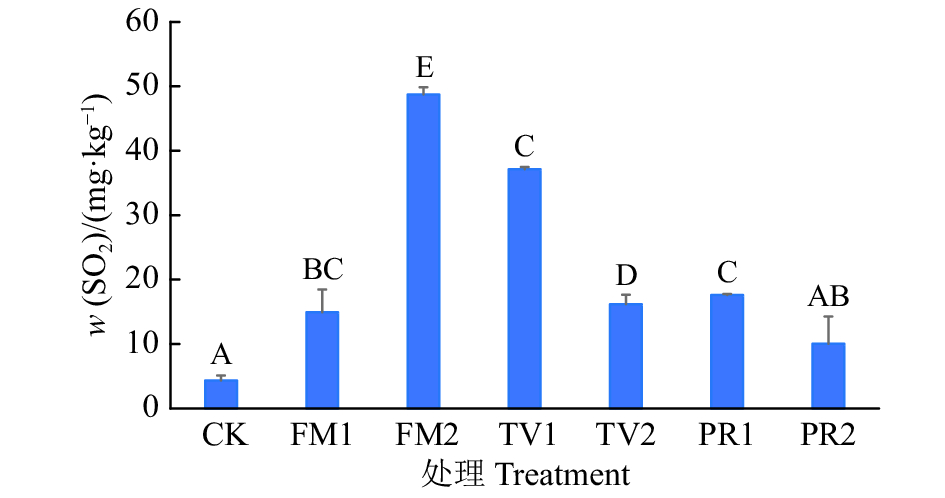Comparison of different preharvest technologies to regulate and control storage quality of Dimocarpus longan fruit
-
摘要:目的
探讨采收成熟度、树势与果期管理对龙眼果实采后贮藏性能和货架寿命的影响。
方法以‘石硖’龙眼Dimocarpus longan Lour. cv. Shixia为材料,以果实成熟度、树势、采前调控为试验因素,设计三因素三水平的单因素试验,采用SO2保鲜纸处理采收的果实并于(5±1) ℃低温贮藏50 d,观察其出库和货架好果率(25 ℃左右),比较不同采前处理果实之间的贮藏性能差异。
结果80%~85%成熟度的适熟果出库好果率和货架好果率均高于完熟(95%~100%成熟度,CK)和过熟果,且过熟果最差。采前病害防治与营养调控果实的出库好果率和货架好果率均显著高于CK(无调控)(P<0.01),其中,采前病害防治效果最好,出库好果率为93.26%;其次是营养调控,出库好果率为84.23%,CK仅为67.71%。3种树势中,强壮树果实贮藏性最好,其次是衰弱树,CK(中庸树)最差。在所有处理中,采前病害防治果实贮藏效果最好,货架存放4 d好果率为84.86%;强壮树、营养调控和衰弱树果实货架4 d好果率分别为63.23%、56.14%和51.12%;过熟果最差,为26.91%。相关分析结果表明,采收时果肉可溶性固形物含量与果肉SO2残留量、货架质损率均呈显著负相关,但与贮藏效果相关性不明显。
结论在龙眼果实生长期,做好采前病害防治和营养调控,合理挂果以保持树势,并于适当成熟度采收果实,可以获得较为理想的贮藏性能和采后寿命。
Abstract:ObjectiveTo investigate the influence of fruit maturity at harvest, tree vigour and preharvest regulation on the storage performance and shelf life of Dimocarpus longan fruit.
MethodD. longan Lour. cv. Shixia fruits were used as experimental material. Three groups of single factor experiments were designed with fruit maturity, tree vigour and preharvest regulation as the experimental factors, and each factor had three levels. The harvested fruits were treated using SO2-released paper and were stored at (5±1) ℃ for 50 days. We observed the good fruit rate after storage (STGFR), and the good fruit rate during shelf life (SFGFR) at (25±1) ℃. The storage performances of fruits with different preharvest treatments were compared.
ResultFruits harvested at appropriate maturity (80%−85% maturity degree) had higher STGFR and SFGFR than those at full maturity (95%−100% maturity degree, CK) and over maturity, and the over matured fruits performed the worst. Both preharvest disease control and nutrition regulation treatments resulted in fruits with higher STGFR and SFGFR compared to CK with significant differences (P<0.01). Among them, disease control treatment performed the best with 93.26% STGFR, followed by nutrition regulation treatment (84.23%), and the worst was CK (67.71%). Among three types of trees with different vigor, fruits from strong tree had the best storability, followed by weak tree, and CK(medium tree) was the worst. Among all treatments, the fruit storability of disease control treatment was the best, with a SFGFR of 84.86% after four days on shelf, followed by strong tree, nutrition regulation and week tree treatments, with SFGFR of 63.23%, 56.14% and 51.12% respectively, and the worst was the over matured fruit (26.91%). The results of correlation analysis indicated that the content of total soluble solids in fruit pulp at harvest was significantly negatively correlated with the amount of SO2 residue in pulp and mass loss rate during shelf life, but not correlated with storability.
ConclusionDuring the fruit growth period of D. longan, performing disease control and nutrition regulation, keeping reasonable tree vigour with suitable fruit setting rate, and harvesting at appropriate maturity can help the fruit obtain better storability and longer shelf life.
-
Keywords:
- Dimocarpus longan /
- fruit maturity /
- tree vigor /
- preharvest regulation /
- storage quality /
- shelf performance
-
-
图 1 不同采前处理龙眼果实贮藏50 d后果实品质比较
相同颜色柱子上的不同大写字母表示处理间差异达到0.01的显著水平(Duncan’s法);CK、FM1、FM2、TV1、TV2、PR1和PR2分别表示对照、适熟、过熟、衰弱树、强壮树、病害防治和营养调控处理
Figure 1. Comparison of fruit quality after stored for 50 days for Dimocarpus longan fruits with different preharvest treatments
Different capital letters on columns of the same color indicate that the difference among treatments reaches 0.01 significance level(Duncan’s method); CK,FM1, FM2, TV1,TV2, PR1 and PR2 represent the following treatments including control, appropriate maturity, over maturity, weak tree, strong tree, disease control and nutrition regulation,respectively
图 2 不同采前处理龙眼果实贮藏50 d后色度指标与采收时CK的差异
相同颜色柱子上的不同大写字母表示处理间差异达到0.01的显著水平(Duncan’s法);采收时CK的色度值为:L*=52.24,a*=9.36,b*=30.82,C*=32.28,h°=73.01
Figure 2. Differences in chroma indicators of Dimocarpus longan fruits with different preharvest treatments after stored for 50 days compared with CK at harvest
Different capital letters on columns of the same color indicate that the difference among treatments reaches 0.01 significance level(Duncan’s method); Chroma indicator values for CK at harvest were: L*=52.24, a*=9.36, b*=30.82, C*=32.28, h°=73.01
图 3 不同采前处理龙眼果实贮藏前后可溶性固形物(TSS)含量及差异
图a中,相同颜色柱子上的不同大写字母表示处理间差异达到0.01的显著水平(Duncan’s法);CK、FM1、FM2、TV1、TV2、PR1和PR2分别表示对照、适熟、过熟、衰弱树、强壮树、病害防治和营养调控处理
Figure 3. Comparison of total soluble solids (TSS) contents in Dimocarpus longan fruits before and after storage with different preharvest treatments and the differences of TSS contents before and after storage
In figure a, different capital letters on columns of the same color indicate that the difference among treatments reaches 0.01 significance level(Duncan’s method); CK, FM1, FM2, TV1,TV2, PR1 and PR2 represent the following treatments including control, appropriate maturity, over maturity, weak tree, strong tree, disease control and nutrition regulation, respectively
图 7 不同采前处理龙眼果实货架期间表现的综合评价
CK、FM1、FM2、TV1、TV2、PR1和PR2分别表示对照、适熟、过熟、衰弱树、强壮树、病害防治和营养调控处理
Figure 7. Comprehensive evaluation of performance during shelf life for Dimocarpus longan fruits with different preharvest treatments
CK, FM1, FM2, TV1,TV2, PR1 and PR2 represent the following treatments including control, appropriate maturity, over maturity, weak tree, strong tree, disease control and nutrition regulation, respectively
图 8 不同采前处理龙眼果实贮藏50 d后果肉SO2含量比较
柱子上的不同大写字母表示处理间差异达到0.01的显著水平(Duncan’s法);CK、FM1、FM2、TV1、TV2、PR1和PR2分别表示对照、适熟、过熟、衰弱树、强壮树、病害防治和营养调控处理
Figure 8. Comparison of SO2 contents in Dimocarpus longan fruits with different preharvest treatments after stored for 50 days
Different capital letters on columns indicate that the difference among treatments reaches 0.01 significance level(Duncan’s method); CK, FM1, FM2, TV1,TV2, PR1 and PR2 represent the following treatments including control, appropriate maturity, over maturity, weak tree, strong tree, disease control and nutrition regulation, respectively
表 1 龙眼果实采前处理设计与采收时间1)
Table 1 Preharvest treatment design and harvesting date for Dimocarpus longan fruits
项目 Item 果实成熟度 Fruit maturity (FM) 树势 Tree vigour (TV) 采前调控 Preharvest regulation (PR) 处理
Treatment适熟
Appropriate
maturity完熟(CK)
Full
maturity过熟
Over
maturity衰弱树
Weak
tree中庸树(CK)
Medium
tree强壮树
Strong
tree病害防治
Disease
control营养调控
Nutrition
regulation无调控 (CK)
No
regulation采收日期
Harvest date07-09 07-16 08-02 07-16 07-16 07-26 07-16 07-16 07-16 1) CK为无采前调控处理的中庸树完全成熟果实
1) CK represents fruit with full maturity harvested from the medium-vigour tree without preharvest regulation表 2 龙眼果实出库及货架表现与品质指标之间的相关性1)
Table 2 Correlations between the performance of Dimocarpus longan fruit after storage and during shelf life and quality indexes
项目 Item w采收(TSS) Δw
(TSS)出库
好果率出库
烂果率ΔL* Δa* Δb* ΔC* Δh° 货架
好果率货架
霉烂率货架
质损率w果肉(SO2) w采收(TSS)
TSS content at harvest1.000 Δw(TSS) 0.810* 1.000 出库好果率
Good fruit rate after storage0.195 0.364 1.000 出库烂果率
Rotten fruit rate after storage−0.259 −0.340 −0.966** 1.000 ΔL* 0.424 0.323 0.785* −0.837* 1.000 Δa* −0.548 −0.740 −0.825* 0.861* −0.706 1.000 Δb* −0.557 −0.513 0.506 −0.478 0.331 0.053 1.000 ΔC* −0.746 −0.797* 0.004 0.097 −0.087 0.548 0.863* 1.000 Δh° 0.418 0.597 0.928** −0.949** 0.800* −0.972** 0.178 −0.343 1.000 货架好果率
Good fruit rate
during shelf life0.109 0.352 0.917** −0.808* 0.624 −0.672 0.608 0.177 0.784* 1.000 货架霉烂率
Mildewy and rotten fruit
rate during shelf life0.355 0.328 −0.619 0.529 −0.588 0.120 −0.935** −0.719 −0.345 −0.670 1.000 货架质损率
Mass loss rate
during shelf life−0.801* −0.997** −0.356 0.331 −0.280 0.735 0.528 0.807* −0.586 −0.342 −0.361 1.000 w果肉(SO2)
SO2 content in flesh−0.757* −0.798* −0.366 0.370 −0.165 0.629 0.369 0.621 −0.506 −0.387 −0.358 0.825* 1.000 1)“*”和“**”分别表示在0.05和0.01水平显著相关
1)“*” and“**” represent significant correlation at level 0.01 and 0.05 levels respectively -
[1] SIDDIQUI M W. Principles and practices for quality maintenance, postharvest biology and technology of horticultural crops[M]. New Jersey: Apple Academic Press, 2015: 89-95.
[2] REICHEL M, CARLE R, SRUAMSIRI P, et al. Influence of harvest maturity on quality and shelf-life of litchi fruit (Litchi chinensis Sonn.)[J]. Postharvest Biology and Technology, 2010, 57(3): 162-175. doi: 10.1016/j.postharvbio.2010.04.005
[3] SALVADOR A, ARNAL L, BESADA C, et al. Physiological and structural changes during ripening and deastringency treatment of persimmon fruit cv. ‘Rojo Brillante’[J]. Postharvest Biology and Technology, 2007, 46(2): 181-188. doi: 10.1016/j.postharvbio.2007.05.003
[4] JU Z G, DUAN Y S, JU Z Q, et al. Different responses of 'Snow Giant' and 'Elegant Lady' peaches to fruit maturity and storage temperature[J]. Journal of Horticultural Science and Biotechnology, 2000, 75(1): 86-91.
[5] 高豪杰, 贾志伟, 李雯, 等. 采收成熟度与果实贮藏保鲜关系的研究进展[J]. 安徽农业科学, 2012, 40(5): 2897-2898. doi: 10.3969/j.issn.0517-6611.2012.05.126 [6] DONG T, XIA R X, XIAO Z Y, et al. Effect of pre-harvest application of calcium and boron on dietary fibre, hydrolases and ultrastructure in ‘Cara Cara’ navel orange (Citrus sinensis L. Osbeck) fruit[J]. Scientia Horticulturae, 2009, 121(3): 272-277. doi: 10.1016/j.scienta.2009.02.003
[7] SIDDIQUI M W. Preharvest modulation of postharvest fruit and vegetable quality[M]. Amsterdam: Elsevier, 2018: 169-182.
[8] ROKAYA P R, BARAL D R, GAUTAM D M, et al. Effect of pre-harvest application of gibberellic acid on fruit quality and shelf life of mandarin (Citrus reticulata blanco)[J]. American Journal of Plant Sciences, 2016(7): 1033-1039.
[9] 韩冬梅, 杨武, 牛佳佳, 等. 龙眼果实低温贮藏性能常规指标评价体系的构建[J]. 热带作物学报, 2015, 36(9): 1685-1693. doi: 10.3969/j.issn.1000-2561.2015.09.023 [10] 韩冬梅, 李建光, 李荣, 等. 不同龙眼品种果实的耐贮性比较[J]. 华南农业大学学报, 2010, 31(4): 6-11. doi: 10.3969/j.issn.1001-411X.2010.04.002 [11] 韩冬梅, 曾婷, 李建光, 等. 龙眼果实挂树成熟与退糖期间的解剖学结构比较[J]. 广东农业科学, 2018, 45(4): 43-50. [12] 张居念, 林河通, 谢联辉, 等. 龙眼果实潜伏性病原真菌的初步研究[J]. 热带作物学报, 2006, 27(4): 78-82. doi: 10.3969/j.issn.1000-2561.2006.04.017 [13] 陈艺晖, 林河通, 林艺芬, 等. 拟茎点霉侵染对龙眼果实采后果皮褐变和活性氧代谢的影响[J]. 中国农业科学, 2011, 44(23): 4858-4866. [14] 刘爱媛, 陈维信, 程海慧. 龙眼采后炭疽病及对贮藏效果的影响[J]. 果树学报, 2006, 23(1): 77-80. [15] 叶素莲, 陈金洪. 钙硫锌硼肥对龙眼产量及品质的影响[J]. 广西农业科学, 2009, 40(6): 696-699. [16] 韦剑锋, 梁和, 韦冬萍, 等. 钙硼营养对龙眼果实品质及耐贮性的影响[J]. 中国农学通报, 2006, 22(9): 311-314. doi: 10.3969/j.issn.1000-6850.2006.09.075 [17] 韦剑锋, 韦冬萍, 何燕文, 等. 喷施钙硼对龙眼叶片和果实矿质营养状况的影响[J]. 西南农业学报, 2007, 20(1): 77-80. doi: 10.3969/j.issn.1001-4829.2007.01.018 [18] LUO T, NIU J J, GUO X M, et al. Preharvest zinc sulfate spray improves the storability of longan (Dimocarpus longan Lour.)fruits by protecting the cell wall components and antioxidants of pericarp[J]. Journal Science of Food and Agriculture, 2019, 99(3): 1098-1107. doi: 10.1002/jsfa.9277
[19] 牛佳佳. 采前矿质营养调控龙眼果实贮藏品质及其分子基础研究[D]. 广州: 华南农业大学, 2014. [20] 韩冬梅, 吴振先, 杨武, 等. 龙眼果实品质评价理化指标体系的构建[J]. 植物遗传资源学报, 2015, 16(3): 503-511. [21] 韩冬梅, 杨武, 吴振先, 等. 龙眼果实贮藏品质理化指标评估体系的构建[J]. 华南农业大学学报, 2015, 36(6): 39-46. doi: 10.7671/j.issn.1001-411X.2015.06.007 [22] SHUAI L, LI J, NIU J J, et al. Sucrose-metabolizing enzymes and their genes in the arils of two Dimocarpus longan cultivars[J]. Biologia Plantarum, 2016, 60(4): 741-748. doi: 10.1007/s10535-016-0602-x
[23] 吴振先, 韩冬梅. 一种龙眼保鲜纸的应用: ZL 201610227848.7[P]. 2018-03-16. [24] 中华人民共和国农业部. 水果、蔬菜及其制品中二氧化硫总量的测定: NY/T 1435—2007[S]. 北京: 中国农业出版社, 2007. [25] 中华人民共和国卫生部, 中国国家标准化管理委员会. 食品中亚硫酸盐的测定: GB/T 5009.34—2003[S]. 北京: 中国标准出版社, 2003. [26] 邓维斌, 唐兴艳, 胡大权, 等. SPSS19.0统计分析实用教程[M]. 北京: 电子工业出版社, 2013: 139-141. [27] 中华人民共和国农业部. 热带水果中二氧化硫残留限量: NY 1440—2007[S]. 北京: 中国农业出版社, 2007. [28] WOOLF A B, BOWEN J H, FERGUSON I B. Preharvest exposure to the sun influences postharvest responses of ‘Hass’ avocado fruit[J]. Postharvest Biology and Technology, 1999, 15(2): 143-153. doi: 10.1016/S0925-5214(98)00077-5
[29] 刘兆东. 果树采前管理对果品质量的影响及优化措施分析[J]. 中国果菜, 2017, 37(3): 28-30. doi: 10.3969/j.issn.1008-1038.2017.03.007 [30] 丁云龙, 张斌斌, 陈星星, 等. 桃树冠不同部位果实低温贮藏期间的品质变化[J]. 果树学报, 2019, 36(12): 1731-1743. [31] KALAJ Y R, GEYER M, HERPPICH W B, et al. Interaction of maximum daily trunk shrinkage and fruit quality in European plum[J]. Erwerbs-Obstbau, 2018, 60(2): 105-112.
[32] 吴大军, 陈妙金, 孙奇男, 等. 采前避雨栽培影响桃果实采后贮藏品质[J]. 果树学报, 2016, 33(1): 96-105. [33] 韩冬梅, 吴振先, 李建光, 等. 龙眼果实采收成熟度与耐贮性关系研究[J]. 华南农业大学学报, 2008, 29(4): 12-16. doi: 10.3969/j.issn.1001-411X.2008.04.003 [34] 韩冬梅, 李建光, 潘学文, 等. 龙眼果实的主要经济性状与耐贮性关系研究[J]. 中国南方果树, 2009, 38(6): 12-15. [35] CHEN M Y, LIN H T, ZHANG S H, et al. Effects of adenosine triphosphate (ATP) treatment on postharvest physiology, quality and storage behavior of longan fruit[J]. Food and Bioprocess Technology, 2015, 8(5): 971-982.
[36] WANG H, QIAN Z J, MA S M, et al. Energy status of ripening and postharvest senescent fruit of litchi (Litchi chinensis Sonn.)[J]. BMC Plant Biology, 2013, 13: 55.




 下载:
下载:
